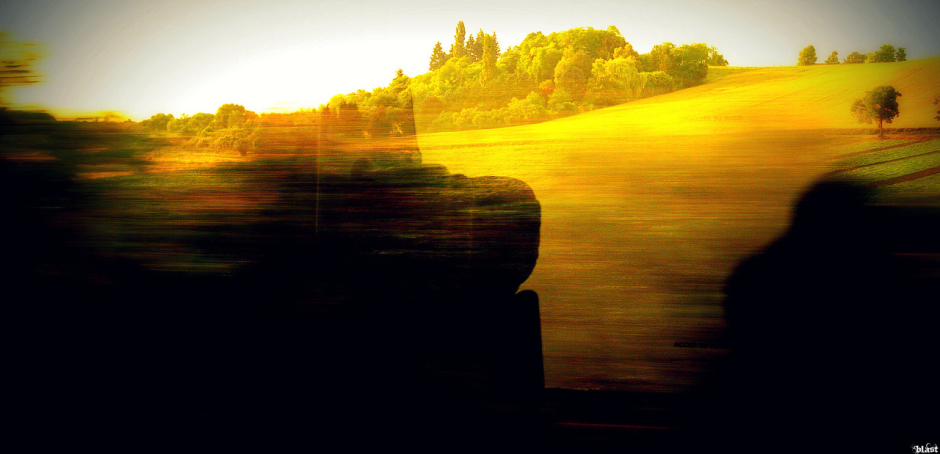This post may contain affiliate links. We may earn money or products from the highlighted keywords or companies or banners mentioned in this post.


Photo: Blast 707 Photography
1. Windowseat views of Europe’s iconic landscapes
We were instantly enchanted by the diversity of scenery as we traveled across Europe by train, from the Barcelona seaside, to flowering plains in Lyon, to the mountain forests and lakes of Bern — all on a day’s trip to Munich. The pace of the train allowed us to truly take in every inch outside our windows, from the color-changing leaves of Germany’s Black Forest region to, later, unexpected castles and ruins in northern Slovakia.
2. Lyrical languages overheard in the corridors
Sharing a car with strangers is an open invitation to eavesdrop — especially if you understand Arabic, Norwegian, German, Taiwanese, Hebrew, or any of the other ways people communicate around the world. We heard them all. The whispers of a French couple nonchalantly discussing politics and the anecdotes robustly shared among a group of young Polish students provided a beautiful soundtrack to the journey.
3. The unpredictable tempo of travel
The speed at which you travel by train varies depending on where you’re going. You might stop 16 times in seven hours between London and Aberdeen, but fantasizing about life in the charming English and Scottish countryside makes it feel like less than that. In contrast, an hour-long trip from Bratislava to Vienna can seem to take an entire day when you’re hungover from partying at Pivovarský Hostinec Richtár Jakub.
4. The nostalgia of train travel itself
For almost 200 years, people have traveled by train. And for the most part, the routes, scenery, and even the stations have changed very little. The Beaux-Arts architecture of Paris’s Gard du Nord transported us to another time, Praha-Holešovice a reminder of the Czech Republic’s Communist past. We lived vicariously through the millions who’d traveled by train before us.
5. The overnight berths
Spending time on a night train is a rite of passage for most Eurail travelers. The berths, sometimes shared with friends, other times with complete strangers, were typically stiff but surprisingly comfortable. The rhythm of the train lulled passengers to sleep in a way that reminded us of a rocking cradle. That is, if the excitement of departing Warsaw after dinner, and arriving in Berlin for breakfast, hadn’t kept us awake the entire time.


Photo: Felix Montino
6. Interactions, verbal and otherwise, with other travelers
It was a brief smile and nod when a new passenger took a seat in our car on the way to Zagreb. It was swapping stories with a group of Australian gap-years planning to hit every European country within the next three months. It was accepting a piece of Belgian chocolate from a six-year-old boy, knowing it was a tasty favorite because his face was covered in the sticky brown sweet stuff.
7. The dining car throwback
Some of these spaces have been modernized, as on trains in Great Britain and Germany, acting more like casual cafes serving salty boxed sandwiches and cans of cola. They’re made for commuters and those looking only for a snack. Others, like you’ll find on routes throughout Eastern Europe, retain their early-20th-century elegance — full meals served by waiters in crimson vests and starched shirts, travelers seated in plush booths beneath the tasseled, frosted-glass lanterns of another era.
8. Scents of body odor, strong perfume, and hot meals
We traveled with Americans who hadn’t showered in days. We remember the scent of the lavender baby powder used by the Belgian mother to help soothe her child’s diaper rash. We craved pizza napoletana, arancini, and every other fragrant Italian delicacy our carmates decided to snack on between Naples and Rome.
9. That feeling of confidence when we mastered the system
We memorized the train times between Bergen and Oslo. We assembled a comprehensive time-killing kit of magazines, postcards, and guidebook reading for that late connection between Sarajevo and Belgrade. Even the Cyrillic script in Sofia’s Central Station failed to intimidate.
10. The fatigue of spending 14 hours on a train
Traveling by rail is more relaxing than any other mode of transport in Europe, but we were still completely drained after the long trips. On the night train from Split to Budapest, we dozed on and off, awoken by the snores of the burly Croat man sharing the car, feeling a bit paranoid about our unguarded possessions, concerned about falling from the top berth if the train stopped suddenly.
11. The organic ebb and flow of the European rail system
The particular pattern of stations, cities, and countries became second nature, the entrance and exit of new and old passengers a natural cycle. The disappearance of a beautiful horizon, quickly replaced by another. The long stretches of comfortable silence, punctuated by the rhythm of the train’s machinery. We established the habit of disembarking from the train, spending a short time in an unfamiliar place, and returning to the station to be transported somewhere new and different once more.


Photo: Alex
12. The Before Sunrise-style missed connections
He was an Israeli chatting over coffee in the dining car. She was a Finnish university student on her way to Bucharest. There was always that moment of “what if?” and a point of hesitation — do we risk getting off at their station, abandoning our itinerary to explore, or stick to our plans and hope someday we’ll meet again? We never got their name, Twitter handle, or life story, but the connection was strong, and memorable.
13. The intriguing juxtapositions of train characters
It was the older gentleman from Hamburg, in his tweed suit, polished wood cane, and worn-in cap, seated next to the eclectically dressed hipster who boarded in Berlin. It was the modelesque Russian woman cuddled up next to her squat, balding sugar daddy on their way to a romantic week in Budapest. There’s something democratizing about traveling Europe by train; and those who choose First Class are missing out.
14. The feeling of standing on a platform, knowing exactly where you’re going, but nothing more
No matter how hard we tried to plan, we could never predict if we’d fall in love at a cafe in Madrid, or have our passport stolen in Frankfurt. Trains can only transport us to and from destinations, they can’t craft our experiences for us. But the anticipation of waiting under the industrial arches of Budapest’s Keleti station to board a train bound for Venezia Santa Lucia is part of that experience.
We could have flown and gotten there quicker, or driven and arrived at our own pace — but somehow we knew there was more to the journey than that.
![]()



This post is proudly produced in partnership with our friends at Eurail.
Posted In:
Destinations:
Powered by WPeMatico











